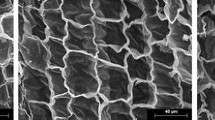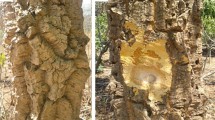Summary
The chemical composition of waxes was studied in Quercus suber cork planks collected in seven localities of the three main production areas of Spain. Waxes were extracted with chloroform (CHCl3) and the extract was submitted to saponification in order to obtain the neutral and acid fractions. The trimethylsilyl derivatives of both fractions were analysed by GC-MS.
The seven populations cannot be distinguished by their total contents of waxes (Chloroform extract) and of the neutral and acid fraction. This lack of differences could be due to the important variability among samples of each population.
The neutral fraction was mainly composed of fatty alcohols (all the even members from C18 to C26, with traces of the intermediate odd members and some unsaturated groups) and triterpenes (11 components, among them friedelin, betulin and cerin were identified) and a very small amount of monocarboxylic fatty acids (C16 and C24 members) was also present. The main group of components of the acid fraction was that of fatty acids (saturated even C14–C24 and odd C15, C17, C21 members, accompanied by a great amount of unsaturated terms and some ω-hydroxyacids, 18-hydroxy-9,12-octadecadienoic and 18-hydroxy-9-octadecenoic acids). Four triterpenes and the C20 and C24 alcohols were also detected in the acid fraction. Significant differences were found among the corks of the various provenances in the global contents of alcohols and triterpenes and in these individual components contents of the neutral fraction. Concerning the differences among the various provenances in the contents of the groups of fatty acids, alcohols, and triterpenes in the acid fraction, a higher number of differences were obtained in the comparisons of the contents of acids and triterpenes, whereas the differences were practically null in the case of the alcohols. When the differences were studied considering the individual compounds, the relation with the behaviour of the contents of the groups of components was not as clear as it happens in the neutral fraction. In this case, the differences were scarcer and they did not show a unique pattern, neither in the components, nor the populations. There is no correspondence in the differences among the provenances regarding the components of the neutral fraction or those of the acid fraction. No clear relationship was found between the geographical proximity of the provenances and chemical similarity of the waxes composition.
Similar content being viewed by others
Author information
Authors and Affiliations
Additional information
Received 12 December 1997
Rights and permissions
About this article
Cite this article
Conde, E., García-Vallejo, M. & Cadahía, E. Waxes composition of Quercus suber reproduction cork from different Spanish provenances. Wood Science and Technology 33, 271–283 (1999). https://doi.org/10.1007/s002260050115
Issue Date:
DOI: https://doi.org/10.1007/s002260050115




